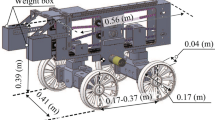Abstract
The subsurface access technology is of great significance to study evolution of stars and probe landing, and the low velocity robotic penetrator (LVRP) is a commonly used detection technique. In this study, a novel LVRP based on ampere force (AFRP) is proposed, which uses the ampere force of the coils located in high intensity magnetic field as the driving force. The AFRP is composed of stator and mover. In the working state, the mover is subjected to a linear reciprocating motion, colliding with the stator, and displacement occurs. Firstly, parametric modeling of AFRP is carried out and the internal magnetic field distribution is analyzed. The results show that the magnetic induction between the two poles can be increased by the relative mounting of the permanent magnets, and the magnetic induction is affected by the gap and the diameter of the permanent magnets. Then, ISIGHT® software is used for integrated optimization, whose purpose is to optimize the design variables and make the output force of each unit reaches the maximum when the casing size of the AFRP is certain. Furthermore, to achieve the optimization design goal that the overall output force is maximum. According to the optimization results, the prototype was developed. The experimental results show that the AFRP operating frequency can be controlled in the range of 1 ~ 10 Hz, the average displacement of each motion cycle is 2 mm. The proposed AFRP can output a larger driving force by changing the current and the number of units. In addition, the AFRP can be used as a novel actuator for robots.
Access this chapter
Tax calculation will be finalised at checkout
Purchases are for personal use only
Similar content being viewed by others
References
Glaser, D.L., Ball, A.J., Zacny, K.A.: A review of penetrometers for subsurface access on comets and asteroids. Meteorit. Planet. Sci. 43, 1021–1032 (2008)
Gouache, T., Yang, G., Gourinat, Y., et al.: Wood Wasp Inspired Planetary and Earth Drill. Research gate Net (2010)
Davies, P., Phipps, A., Taylor, M., et al.: UK Lunar Science Missions: Moonlite & Moonraker, Bremen, pp. 774–779 (2007)
Banaszkiewicz, M., Grygorczuk, J., Marczewski, W., et al.: Rosetta, a cornerston mission of ESA: objectives, instruments and the Polish contribution. In: International Conference on Microwaves, Radar, and Wireless Communications, pp. 1–4 (2014)
Grygorczuk, J., Wisniewski, Ł., et al.: High energy and efficiency penetrator – HEEP. In: 15th European Space Mechanisms & Tribology Symposium-ESMATS 2013, Noordwijk, The Netherlands (2013)
Grygorczuk, J., Seweryn, K., Przybyla, R., et al.: Priorities of the SMRL SRC PAS involvement in exploration of the planetary bodies’ surface based on the existing and planned to be developed technologies. In: International Conference on Microwave Radar and Wireless Communications, pp. 422–425. IEEE (2012)
Spohn, T., Seiferlin, K., Hagermann, A., et al.: Mupus – a thermal and mechanical properties probe for the rosetta lander Philae. Space Sci. Rev. 128(1), 339–362 (2007)
Grygorczuk, J., Banaszkiewicz, M., Seweryn, K., et al.: MUPUS insertion device for the Rosetta mission. Space Technol. 17(6), 59–64 (2007)
Seweryn, K., Banaszkiewicz, M., Bednarz, S., et al.: Mole penetrator ‘KRET’ for Lunar Exploration (2011)
Grygorczuk, J., Seweryn, K., et al.: Technological features in the new mole penetrator “KRET”. In: 13th European Space Mechanisms and Tribology Symposium– ESMATS 2009 (2009)
Lichtenheldt, R., Schäfer, B., Krömer, O.: Hammering beneath the surface of Mars - modeling and simulation of the impact-driven locomotion of the HP3-Mole by coupling enhanced multi-body dynamics and discrete element method. In: 58th Ilmenau Scientific Colloquium Technische Universität Ilmenau (2014)
Spohn, T., Grott, M., Knollenberg, J., et al.: InSight: measuring the martian heat flow using the heat flow and physical properties package (HP3). In: Lunar and Planetary Science Conference, p. 1916 (2012)
Grygorczuk, J., Banaszkiewicz, M., Seweryn, K., et al.: Space penetrators — Rosetta case study. In: International Conference on Methods and MODELS in Automation and Robotics, pp. 441–447 (2013)
Dempsey, N.M., Walther, A., May, F., et al.: High performance hard magnetic NdFeB thick films for integration into micro-electro-mechanical systems. Appl. Phys. Lett. 90(9), 535 (2007)
Alqadi, M.K., Alzoubi, F.Y., Saadeh, S.M., et al.: Force analysis of a permanent magnet and a superconducting hollow cylinder. J. Supercond. Novel Magn. 25(5), 1469–1473 (2012)
Harrold, W.: Calculation of equipotentials and flux lines in axially symmetrical permanent magnet assemblies by computer. IEEE Trans. Magn. 8(1), 23–29 (1972)
Acknowledgments
This work is supported by Research Fund of China Manned Space Engineering (050102), the Key Research Program of the Chinese Academy of Sciences (Y4A3210301), the National Science Foundation of China (51175494, 61128008, and 51575412), and the State Key Laboratory of Robotics Foundation.
Author information
Authors and Affiliations
Corresponding author
Editor information
Editors and Affiliations
Rights and permissions
Copyright information
© 2017 Springer International Publishing AG
About this paper
Cite this paper
Feng, J., Liu, J., Zhang, F. (2017). A Novel Low Velocity Robotic Penetrator Based on Ampere Force. In: Huang, Y., Wu, H., Liu, H., Yin, Z. (eds) Intelligent Robotics and Applications. ICIRA 2017. Lecture Notes in Computer Science(), vol 10464. Springer, Cham. https://doi.org/10.1007/978-3-319-65298-6_55
Download citation
DOI: https://doi.org/10.1007/978-3-319-65298-6_55
Published:
Publisher Name: Springer, Cham
Print ISBN: 978-3-319-65297-9
Online ISBN: 978-3-319-65298-6
eBook Packages: Computer ScienceComputer Science (R0)




